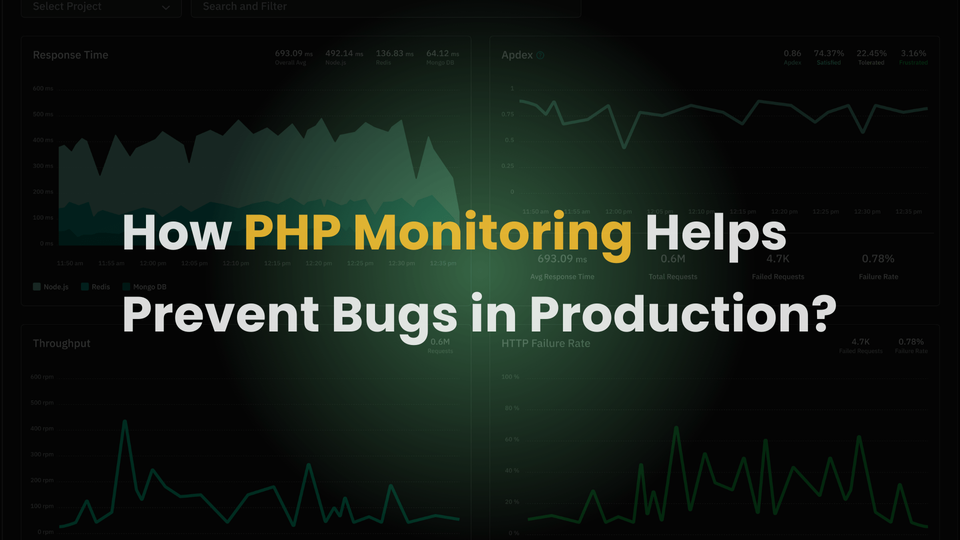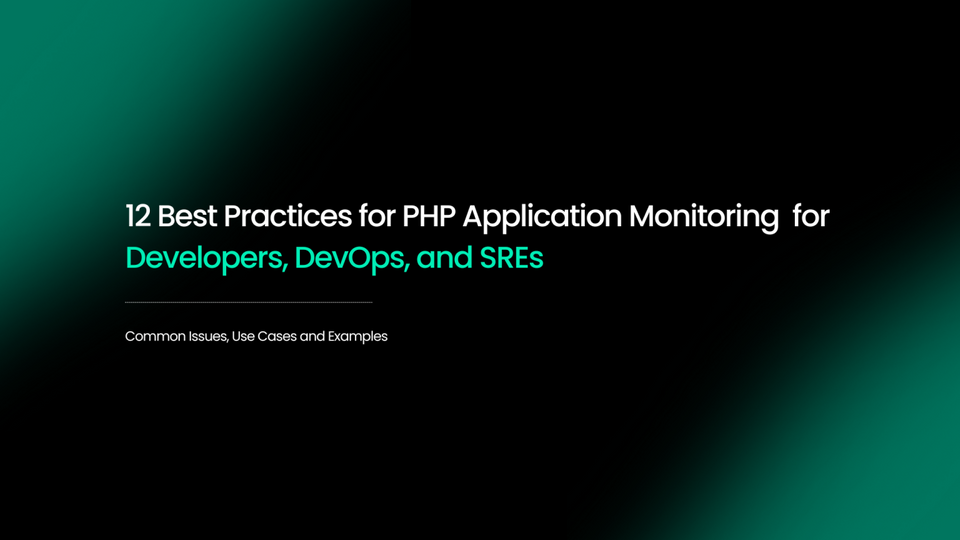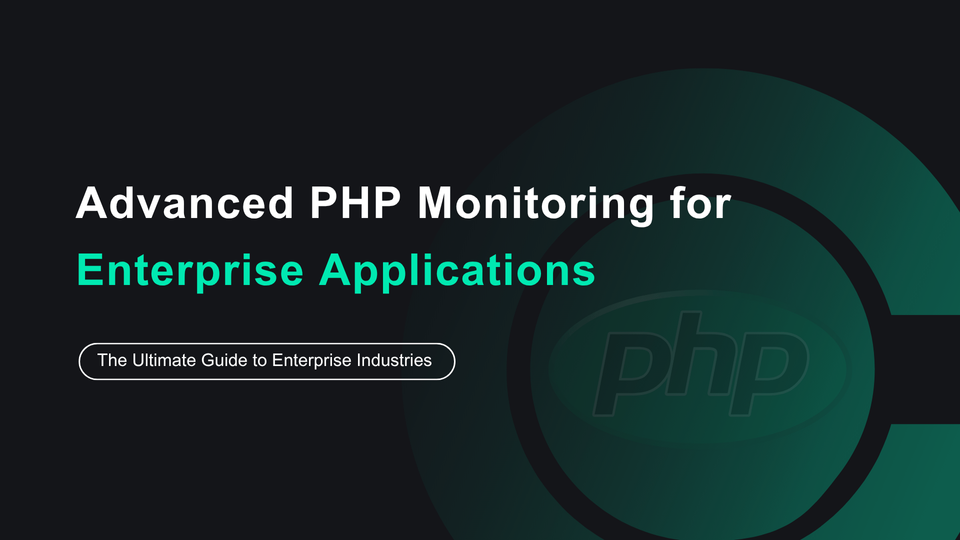How PHP Monitoring Helps Prevent Bugs in Production?
When a PHP application hits production, the stakes are high. Even a minor bug can escalate into downtime, data loss, or frustrated customers. For developers, DevOps teams, and SREs, the real challenge is not just writing efficient code but ensuring that the application continues to run flawlessly in production.
This is where PHP monitoring tools play a critical role. With the right PHP Application Performance Monitoring (APM) solution, teams can detect bugs early, optimize performance, improve security, and ensure maximum availability.
What’s in this article?
- Why PHP monitoring is essential to prevent bugs in production?
- Key Factors Driving Performance and How PHP Monitoring Helps
- How Atatus stands out as the best APM solution for PHP applications?
- FAQs on PHP Monitoring
Why PHP monitoring is essential to prevent bugs in production?
Catching bugs in development is easier, but once they slip into production, the consequences become far more serious. They can affect your business in several ways:
- Revenue loss: Downtime leads to missed transactions.
- Reputation damage: Users expect seamless experiences; one bug can lead to negative reviews or churn.
- Complex debugging: Without the right monitoring, it’s like searching for a needle in a haystack.
- Increased costs: Fixing a production bug costs significantly more than addressing it in testing.
For DevOps and SRE teams managing large-scale applications, manual monitoring is no longer enough. You need automated, real-time PHP monitoring that provides early detection and full visibility.
💡 Also read → PHP Monitoring Best Practices for Developers, DevOps, and SREs
Key Factors Driving Performance and How PHP Monitoring Helps
1. Early Detection and Debugging
One of the biggest advantages of PHP monitoring is identifying issues before they impact end-users.
How PHP Monitoring Helps?
- Real-time error detection: Errors such as undefined variables, database query failures, or memory leaks are instantly detected and flagged.
- Error categorization: Distinguishes between fatal errors, warnings, and exceptions for faster triage.
- Root cause analysis: Instead of sifting through logs, monitoring provides a clear trace of what went wrong and where.
Example Scenario
Imagine a user hits the checkout page of an eCommerce site, but a hidden SQL query bug causes the request to fail. Without monitoring, you’d only know when users complain. With PHP monitoring tool, the error is flagged instantly with full stack trace and contextual data which allow engineers to fix it before it snowballs into lost revenue.
💡 Also read → Optimize Your E-Commerce Platform with PHP Performance Monitoring
2. Performance Optimization
Not every production issue comes from outright bugs, sometimes it’s slow performance that frustrates users.
How PHP Monitoring Helps?
- Transaction tracing: Identifies which functions, queries, or external services are slowing down response times.
- Database performance monitoring: Detects slow SQL queries that often cause bottlenecks.
- Memory and CPU usage insights: Ensures efficient resource utilization.
- Apdex and latency scores: Quantify the actual end-user experience.
Example Scenario
A news site experiences slow page loads during peak traffic. With transaction traces, you can see that a third-party API call is dragging performance down. With this visibility, you can optimize caching or asynchronous calls which deliver faster response times to end-users.
💡 Also read → How APM Can Improve Your Digital Customer Experience?
3. Improved Security
Production environments are the prime targets for cyber attacks and vulnerabilities. While monitoring isn’t a replacement for security audits, it acts as a first line of defense by exposing unusual patterns.
How PHP Monitoring Helps?
- Detects anomalies: Suspicious spikes in error rates or unusual access patterns.
- Exposes misconfigurations: Security missteps like exposing error logs or debug info in production.
- Monitors dependencies: Vulnerabilities in third-party libraries are surfaced when unusual errors occur.
Example Scenario
A sudden rise in failed login attempts may point to a brute-force attack. Atatus helps you detect this in real-time, giving your team the chance to apply mitigations such as IP blocking or rate limiting.
4. Enhanced Availability and Uptime
For DevOps and SREs, uptime is the ultimate metric. Bugs in production often manifest as crashes or downtime that directly affect SLAs.
How PHP Monitoring Helps?
- Error rate tracking: Monitors error percentages relative to requests.
- Crash detection: Alerts when services stop responding.
- Alerting and notifications: Integrates with Slack, PagerDuty, or email to notify teams instantly.
- Service-level visibility: Ensures uptime benchmarks are met.
Example Scenario
A SaaS app suffers intermittent downtime due to high memory usage. Without monitoring, users complain first. With Atatus, teams get instant alerts when memory spikes occur, helping them scale resources or optimize code before the crash happens.
💡 Also read →How to Reduce Application Downtime with APM?
5. Deep Visibility and Contextual Information
Debugging in production often fails because teams lack context. PHP monitoring solves this by capturing every detail surrounding an error or slow transaction.
How PHP Monitoring Helps?
- Full stack traces: Shows the exact code path leading to an issue.
- Session traces: Correlates user interactions with backend events.
- Distributed tracing: Provides visibility across microservices and APIs.
- Log correlation: Links logs, metrics, and traces for complete understanding.
Example Scenario
A fintech app notices that transactions occasionally fail, but only under certain conditions. Atatus connects the dots that showing which user request triggered which backend service call, database query, and log entry. Instead of guesswork, engineers get a clear timeline of the failure.
How Atatus stands out as the best APM solution for PHP applications?
If you’re a DevOps engineer, developer, or SRE responsible for keeping PHP applications stable and bug-free in production, you need more than just logs—you need a full-stack APM solution.
Atatus delivers:
- Faster bug detection before customers notice
- Detailed debugging context with traces, logs, and metrics
- Optimized performance through transaction and database monitoring
- Better security awareness by detecting anomalies early
- Reliable uptime through proactive alerts
With Atatus, you’ll spend less time chasing bugs and more time building features your users love.
Next Step!
Bugs in production don’t just impact performance, they directly affect user trust and business growth. With Atatus PHP Monitoring, your team can move from chasing production issues.
Don’t wait for the next production outage to realize the value of monitoring.
👉 Request a demo today or Sign up for free to see how Atatus helps you resolve issues faster & delivers the best APM experience for PHP monitoring.
FAQs on PHP Monitoring
What is the best PHP monitoring tool for DevOps and SRE teams?
For DevOps engineers and SREs, the best PHP monitoring tool should provide end-to-end visibility, real-time alerts, distributed tracing, and easy integration with existing workflows. Atatus is a leading choice because it’s lightweight, affordable, and delivers deep contextual insights without the complexity or cost of tools like Datadog or New Relic.
Can Atatus help detect slow SQL queries in my PHP app?
Yes. Atatus tracks database query performance and highlights slow or inefficient queries. You can see how each query impacts transaction response times and get detailed traces for tuning database performance.
Will PHP monitoring impact my application performance?
Atatus uses a lightweight agent that adds minimal overhead. It’s designed to provide high-resolution insights without slowing down your app, even under high traffic.
Is Atatus suitable for small teams or only for enterprises?
Atatus is built for startups, scaling SaaS businesses, and large enterprises alike. Its flexible, cost-effective pricing ensures small teams can adopt it without burning budgets, while enterprises can scale seamlessly.
#1 Solution for Logs, Traces & Metrics
APM
Kubernetes
Logs
Synthetics
RUM
Serverless
Security
More





